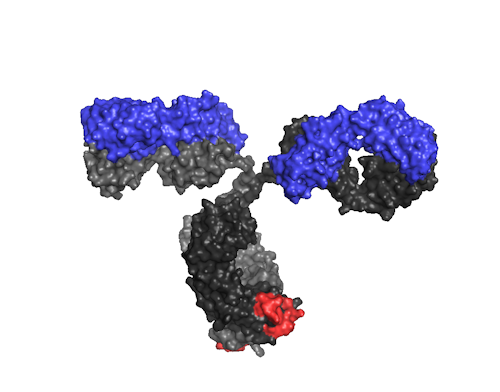Bispecific antibodies with monovalent antigen engagement in the Fc domain
PRINCIPAL INVESTIGATOR: Florian Rüker
Background.
Bispecific antibodies that can simultaneously bind to two targets hold great promise as therapeutic agents for several reasons: while they keep the favourable properties of monoclonal antibodies, such as precise specificity and long half-life in vivo, their biological activity as well as their selectivity can be enhanced by binding to a second antigen or epitope, which may be identical with or different from the primary antigen. The therapeutic effect can be enhanced by more potent blocking of a cytokine or simultaneous blocking of multiple different cytokine molecules. Bispecific antibodies can bind a target tumour cell with enhanced selectivity by an avidity effect of binding to each of the target cell-bound antigens with moderate affinity. Another mode of action of bispecific antibodies is bridging of target cells and effector cells, enabling potent target cell killing by inducing specific cytotoxicity.
These attractive properties are the key motivation behind the intense efforts invested into the engineering of bispecific antibodies during the last decades. One promising clinical-stage bispecific antibody format is the mAb2, where an additional antigen binding site is incorporated into the Fc part of the antibody. The basis for this format is the so called Fcab, an Fc fragment that is designed to bind to an antigen through engineered loops at the bottom of the Y-shaped antibody molecule, i.e. in the CH3 domain. Such Fcabs are selected in vitro from large libraries that contain Fc clones in which these loop regions are present in randomised form. Once an antigen binding Fcab is isolated it can be used as a building block in any antibody by introducing the CH3 domain binding site into the natural Fc, thus creating a bispecific antibody, which is termed mAb2. Since the CH3 domains in the Fc form a homodimeric structure, mAb2 have the potential of binding to both targets in a bivalent manner.
Aims and methods.
Fcabs with a pair of modified CH3 domains can potentially interact with two antigen molecules. In several situations, monovalent antigen engagement would, however, be preferred to avoid antigen crosslinking.
The objective of the project is to design bispecific heterodimeric mAb2 that enable a monovalent binding by their Fcab part and in addition provide a variety of novel topologies of the second antigen-binding site. The results of the study are envisioned to include a source of these novel molecules and a description of methods for their discovery, as well as a thorough analysis of their biophysical properties and biological activity.
Homology between antibody domains has triggered the idea to generate miniaturized antibody fragments, in which the constant domains of the Fab fragment are replaced for a pair of CH3 domains. Such Fab-like fragments could be engineered using exclusively human sequences to connect the variable and CH3 domains. The domain-exchanged Fab-like fragments bind the antigen to the same extent as the parental Fab fragment. Further, such constructs have been introduced into the context of a full-length antibody. However, an engineering challenge remains to develop a bispecific Fab-like CH3 domain-exchanged construct (FabCab), consisting of antibody variable domains and antigen-binding CH3 domains.
The hypothesis of our research is that Fcab-derived antigen-binding CH3 domains can be incorporated into a Fab-like format to produce bispecific molecules. Modified CH3 domains can also be derived from an Fcab clone. In order to provide proof of principle for this, we here specifically will aim to:
- Construct yeast display libraries for affinity selection of monovalent Fcabs
- Examine selected Fcabs in mAb2 format for their biological activity and biophysical properties
- Introduce antigen binding CH3 domains into a FabCab format
- Test the binding and biological activity of these recombinant proteins and describe their biophysical and biochemical properties
MACS and FACS-based affinity selections will be performed and selected clones will be expressed as soluble mAb2 molecules and tested for binding to both antigens and for their biological activity. The postulated binding stoichiometry will be verified using MALS and ITC experiments. Further, their biochemical and biophysical properties such as thermostability, monomeric content and serum stability, will be examined. Chosen Fcab-derived CH3 domains will be the fusion partners for the variable domains in the bispecific FabCab using described design principles. These molecules will be tested for their binding activity and biophysical and biochemical properties and their performance in relevant bioassays will be examined.
Optimization of this miniaturized bispecific format may potentially provide a novel class of molecules with properties that may be of advantage in diagnostic and therapeutic applications.

Trivedi A, et al. Clinical Pharmacology and Translational Aspects of Bispecific Antibodies. Clin Transl Sci. 2017 May;10(3):147-162.
Wozniak-Knopp G, et al. Designing Fcabs: well-expressed and stable high affinity antigen-binding Fc fragments. Protein Eng Des Sel. 2017 Sep 1;30(9):657-671.
M. Kraman, et al. Dual blockade of PD-L1 and LAG-3 with FS118, a unique bispecific antibody, induces CD8+ T-cell activation and modulates the tumor microenvironment to promote antitumor immune responses, Cancer Res. (2018). doi:10.1158/1538-7445.AM2018-2719.
Wozniak-Knopp G, et al. Introducing antigen-binding sites in structural loops of immunoglobulin constant domains: Fc fragments with engineered HER2/neu-binding sites and antibody properties. Protein Eng Des Sel. 2010 Apr;23(4):289-97.
Lobner E, et al. Fcab-HER2 Interaction: a Ménage à Trois. Lessons from X-Ray and Solution Studies. Structure. 2017 Jun 6;25(6):878-889.e5.
Wozniak-Knopp G, et al. An antibody with Fab-constant domains exchanged for a pair of CH3 domains. PLoS One. 2018 Apr 9;13(4):e0195442
